SEO
How to Fix Referral Traffic Spikes in Google Analytics 4

 Notice a huge spike in your referral traffic in the last month? Confused as to why a bunch of people from Poland are suddenly interested in your website? If so, you’re not the only one.
Notice a huge spike in your referral traffic in the last month? Confused as to why a bunch of people from Poland are suddenly interested in your website? If so, you’re not the only one.
In my routine checks of our Google Analytics 4 (GA4) accounts, I found several with a spike in unusual referral traffic. After investigating, I also found that other webmasters are seeing spam referral traffic from sites like news.grets.stor(e) and static.seders.websit(e).
Webmaster’s Note: Please do not visit these websites.
This kind of thing skews your traffic data, so you need to remove as much of it as possible. Here’s how to fix referral traffic spikes in Google Analytics 4:
How to Find Where Referral Traffic Comes From
Go into your traffic acquisition report on your GA4 property. Filter results to session source, and then check your referral traffic.
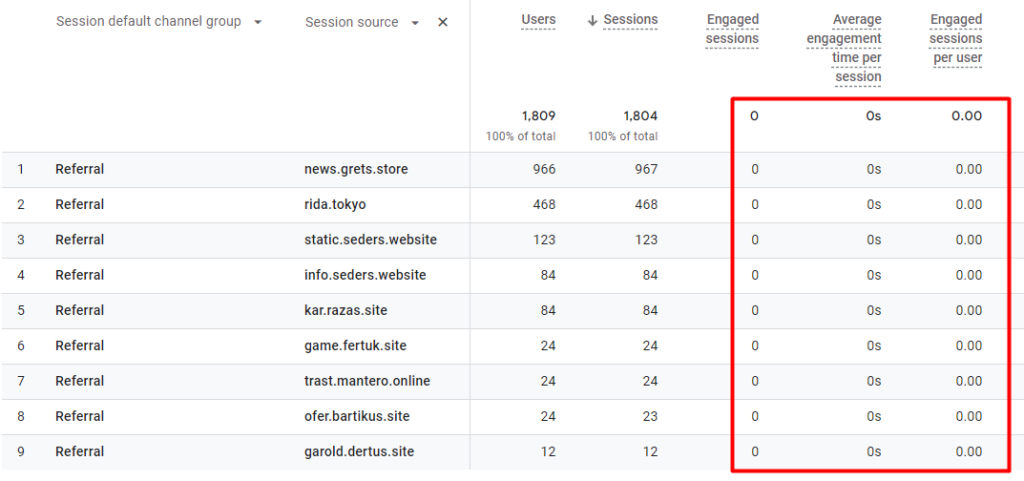

If you see that these sources result in no time on site, no engagement, etc. then you’re experiencing ghost referral traffic.
How to Remove Unusual Referral Traffic From Your GA4
GA4 does give you some options to fix referral traffic spikes by blocking or filtering out specific domains from your data. Doing this will prevent any new traffic from these sources from being recorded in your reports.
To set this up, you will need to have admin access to your GA4 property.
Set as Unwanted Referrals
The first solution is to set the domain as an unwanted referral.
In your GA4 property, go to the admin page (click on the gear icon on the bottom left of your screen).
Then, navigate to the Data Collection Tab and select Data streams.


Select the affected data stream. A side-out window will pop up. Scroll down to the Configure tag settings option. Another side-out window should come out.


Scroll down and click on show more, then on List unwanted referrals.
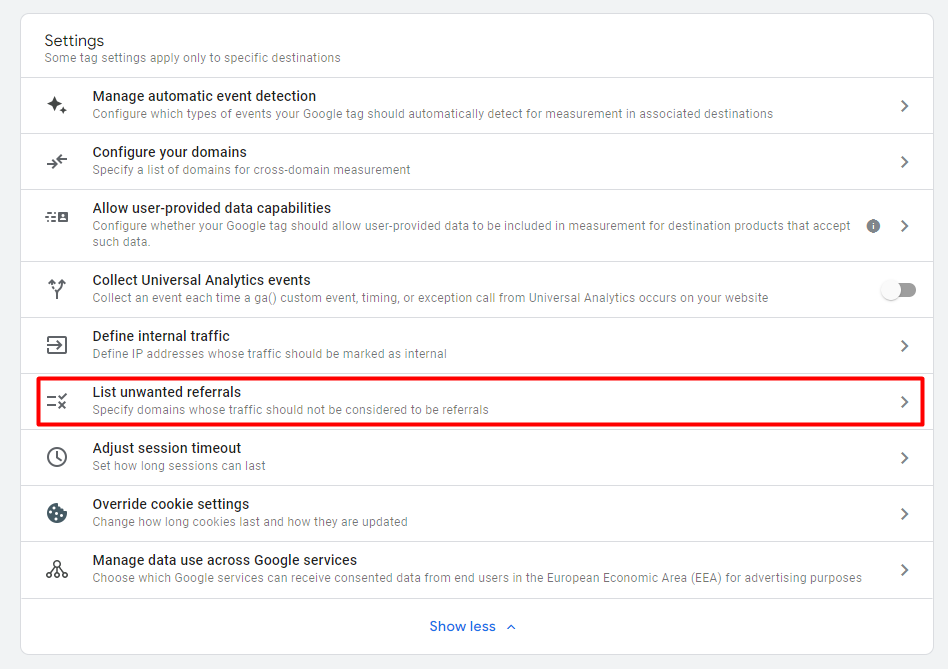

Then simply enter the domain names where the ghost referral traffic is coming from. You may notice new or more websites than what we mentioned above.
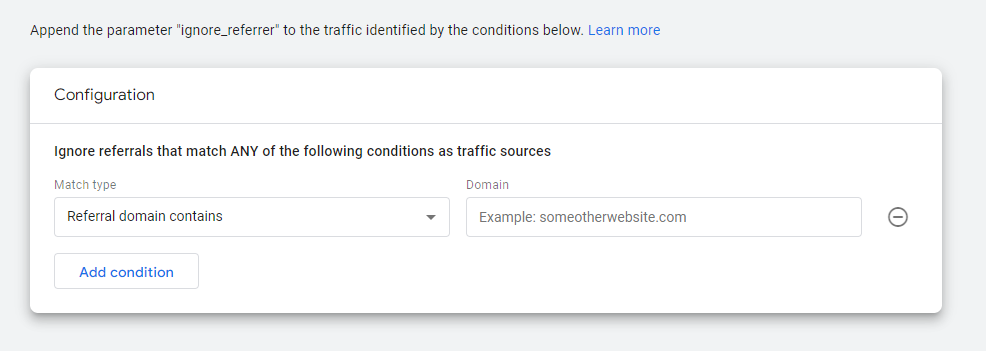

Save your settings. This will stop any new traffic being registered in analytics from this source.
However, this fix can lead to traffic from these sources being tagged as direct traffic instead of referral traffic. Any data that your property collected before you changed your unwanted referral settings can’t be removed as well. Keep those things in mind if you decide to use this solution.
Define Internal Traffic
Another solution to ghost referral traffic is to flag traffic from these domains as internal traffic.
For this solution, you will need the IP addresses of the domains.
Once you have them, go back to your admin page. Again, go to the Data streams page, click on the affected stream, and click on Configure tag settings.
This time, go to Define internal traffic.
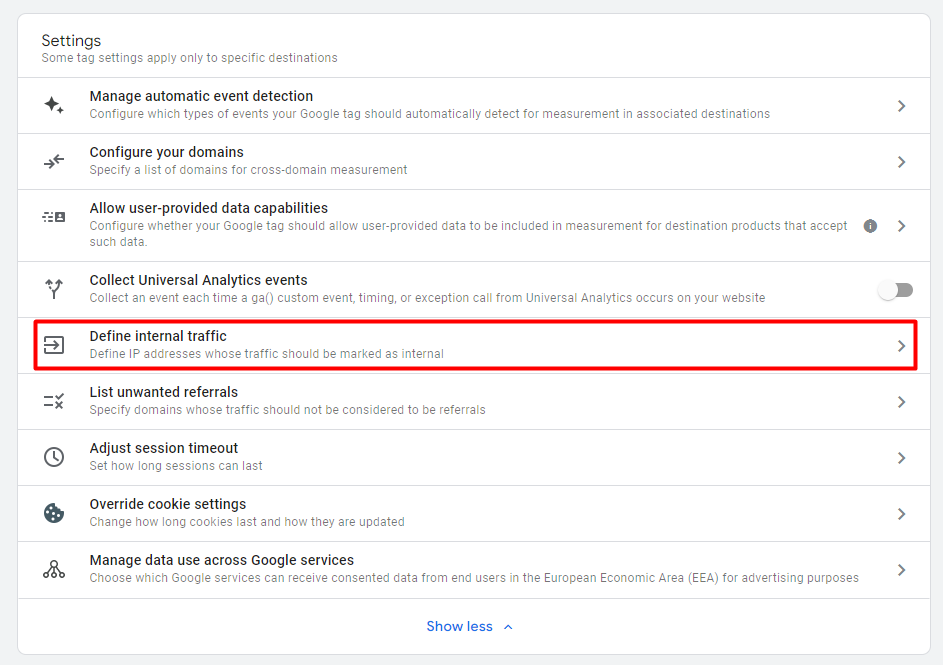

Click create, Add the IPs to block.
You can add multiple conditions in this internal traffic rule, so you don’t need to make a new rule for every domain IP you find.


You can also block their IP ranges rather than specific IPs as they will likely be shifting IP addresses or using dynamic IPs.
Once you’re done adding all the IPs you need to, go back to the Data collection and modification section, and click on Data filters. Click on internal traffic, and set the filter state to Active. Save and apply this setting to your property.
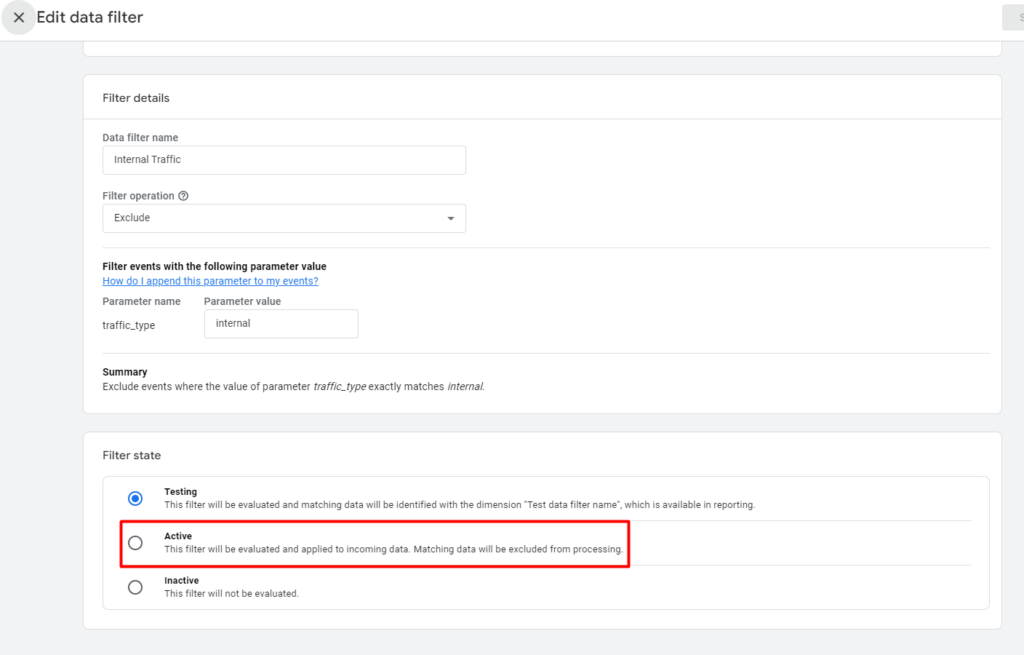

How to Find Domain IPs
Finding the IP of a domain is easy. I use https://who.is as this shows you the registrar details of any domain you submit. Do this for any dubious, spammy referring websites that you find in your GA4 data.
How to Remove Existing Ghost Referral Traffic From Reports
If you want to exclude existing ghost referral traffic data for your reports, you can create a filtered segment in the Explore tab.
Just open a new or existing exploration you have. Then, select a new user segment, with the condition that the page referrer does not contain the domains you want to filter out.
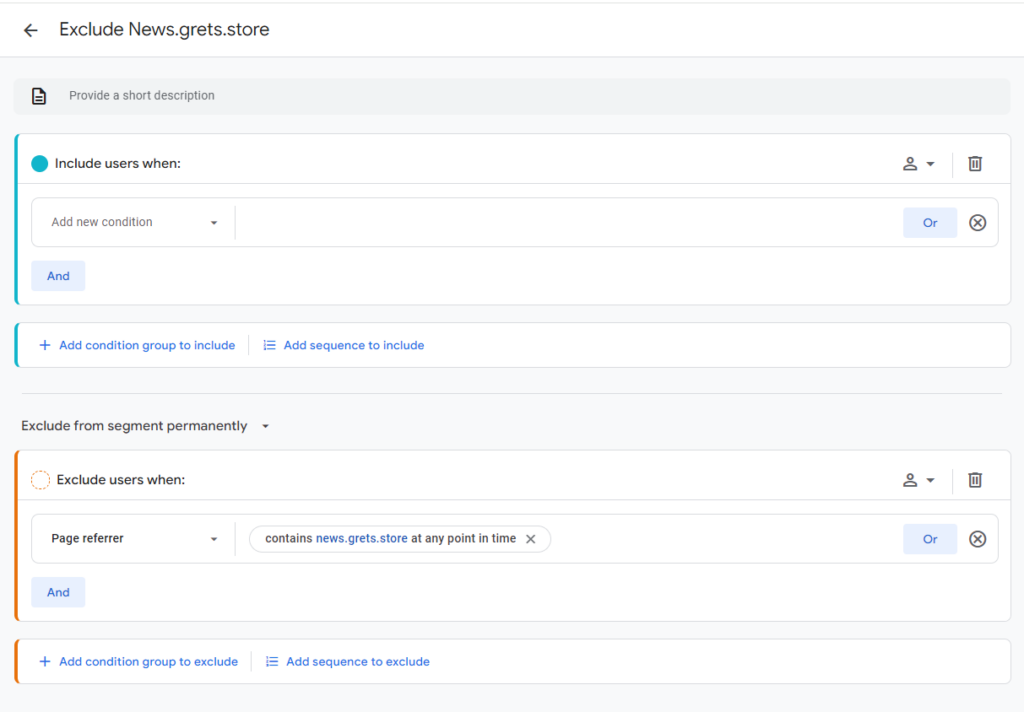

Name this segment to make it easier to find later on. Click apply, and you should be able to use this segment in the exploration view to exclude traffic from these domains. This will impact any other dashboards and reports you have in Looker Studio.
You can also filter these out in the GA4-generated reports by using the add filter option. In any report, click add filter. In the side-out menu, select session source. For match type, select does not exactly match. Then, for values, select all the domains you want to filter out.


Once you’re done, simply click apply and the report should exclude data coming from those domains.
And that’s how you fix referral traffic spikes in GA4.
Why Ghost Referral Traffic Exists
You might be wondering why these sites are doing this. There are a few goals they might be trying to meet.
Some spam-y websites like these will flood your GA4 in the hopes that you will notice their domain in your reports, become curious about where the hundreds and hundreds of users are coming from, and visit their site.
If it’s a malicious website, it might be doing this for malware or phishing scams, luring users to their websites so they can steal data. Otherwise, this might be just another way to increase their site’s visibility and traffic.
Another reason is linked to link building. By being a noticeable issue in so many webmasters’ GA4s, they create an opportunity to get mentioned in blog posts and forums, especially by those who publish their traffic data publicly or share it unknowingly. This can boost the perceived authority and ranking of the spam domains in search engine results.
This scheme is also used to create fake referral traffic to sites offering affiliate programs. Some people use this to increase the commissions they earn from this traffic.
Lastly, it’s common in broader black-hat strategies. Black-hat SEOs use this to generate a large number of visits focused on specific keywords, in an attempt to manipulate rankings – though I have seen this become less and less effective as Google’s algorithms continue to evolve.
SEO
Google March 2024 Core Update Officially Completed A Week Ago

Google has officially completed its March 2024 Core Update, ending over a month of ranking volatility across the web.
However, Google didn’t confirm the rollout’s conclusion on its data anomaly page until April 26—a whole week after the update was completed on April 19.
Many in the SEO community had been speculating for days about whether the turbulent update had wrapped up.
The delayed transparency exemplifies Google’s communication issues with publishers and the need for clarity during core updates
Google March 2024 Core Update Timeline & Status
First announced on March 5, the core algorithm update is complete as of April 19. It took 45 days to complete.
Unlike more routine core refreshes, Google warned this one was more complex.
Google’s documentation reads:
“As this is a complex update, the rollout may take up to a month. It’s likely there will be more fluctuations in rankings than with a regular core update, as different systems get fully updated and reinforce each other.”
The aftershocks were tangible, with some websites reporting losses of over 60% of their organic search traffic, according to data from industry observers.
The ripple effects also led to the deindexing of hundreds of sites that were allegedly violating Google’s guidelines.
Addressing Manipulation Attempts
In its official guidance, Google highlighted the criteria it looks for when targeting link spam and manipulation attempts:
- Creating “low-value content” purely to garner manipulative links and inflate rankings.
- Links intended to boost sites’ rankings artificially, including manipulative outgoing links.
- The “repurposing” of expired domains with radically different content to game search visibility.
The updated guidelines warn:
“Any links that are intended to manipulate rankings in Google Search results may be considered link spam. This includes any behavior that manipulates links to your site or outgoing links from your site.”
John Mueller, a Search Advocate at Google, responded to the turbulence by advising publishers not to make rash changes while the core update was ongoing.
However, he suggested sites could proactively fix issues like unnatural paid links.
“If you have noticed things that are worth improving on your site, I’d go ahead and get things done. The idea is not to make changes just for search engines, right? Your users will be happy if you can make things better even if search engines haven’t updated their view of your site yet.”
Emphasizing Quality Over Links
The core update made notable changes to how Google ranks websites.
Most significantly, Google reduced the importance of links in determining a website’s ranking.
In contrast to the description of links as “an important factor in determining relevancy,” Google’s updated spam policies stripped away the “important” designation, simply calling links “a factor.”
This change aligns with Google’s Gary Illyes’ statements that links aren’t among the top three most influential ranking signals.
Instead, Google is giving more weight to quality, credibility, and substantive content.
Consequently, long-running campaigns favoring low-quality link acquisition and keyword optimizations have been demoted.
With the update complete, SEOs and publishers are left to audit their strategies and websites to ensure alignment with Google’s new perspective on ranking.
Core Update Feedback
Google has opened a ranking feedback form related to this core update.
You can use this form until May 31 to provide feedback to Google’s Search team about any issues noticed after the core update.
While the feedback provided won’t be used to make changes for specific queries or websites, Google says it may help inform general improvements to its search ranking systems for future updates.
Google also updated its help documentation on “Debugging drops in Google Search traffic” to help people understand ranking changes after a core update.
Featured Image: Rohit-Tripathi/Shutterstock
FAQ
After the update, what steps should websites take to align with Google’s new ranking criteria?
After Google’s March 2024 Core Update, websites should:
- Improve the quality, trustworthiness, and depth of their website content.
- Stop heavily focusing on getting as many links as possible and prioritize relevant, high-quality links instead.
- Fix any shady or spam-like SEO tactics on their sites.
- Carefully review their SEO strategies to ensure they follow Google’s new guidelines.
SEO
Google Declares It The “Gemini Era” As Revenue Grows 15%

Alphabet Inc., Google’s parent company, announced its first quarter 2024 financial results today.
While Google reported double-digit growth in key revenue areas, the focus was on its AI developments, dubbed the “Gemini era” by CEO Sundar Pichai.
The Numbers: 15% Revenue Growth, Operating Margins Expand
Alphabet reported Q1 revenues of $80.5 billion, a 15% increase year-over-year, exceeding Wall Street’s projections.
Net income was $23.7 billion, with diluted earnings per share of $1.89. Operating margins expanded to 32%, up from 25% in the prior year.
Ruth Porat, Alphabet’s President and CFO, stated:
“Our strong financial results reflect revenue strength across the company and ongoing efforts to durably reengineer our cost base.”
Google’s core advertising units, such as Search and YouTube, drove growth. Google advertising revenues hit $61.7 billion for the quarter.
The Cloud division also maintained momentum, with revenues of $9.6 billion, up 28% year-over-year.
Pichai highlighted that YouTube and Cloud are expected to exit 2024 at a combined $100 billion annual revenue run rate.
Generative AI Integration in Search
Google experimented with AI-powered features in Search Labs before recently introducing AI overviews into the main search results page.
Regarding the gradual rollout, Pichai states:
“We are being measured in how we do this, focusing on areas where gen AI can improve the Search experience, while also prioritizing traffic to websites and merchants.”
Pichai reports that Google’s generative AI features have answered over a billion queries already:
“We’ve already served billions of queries with our generative AI features. It’s enabling people to access new information, to ask questions in new ways, and to ask more complex questions.”
Google reports increased Search usage and user satisfaction among those interacting with the new AI overview results.
The company also highlighted its “Circle to Search” feature on Android, which allows users to circle objects on their screen or in videos to get instant AI-powered answers via Google Lens.
Reorganizing For The “Gemini Era”
As part of the AI roadmap, Alphabet is consolidating all teams building AI models under the Google DeepMind umbrella.
Pichai revealed that, through hardware and software improvements, the company has reduced machine costs associated with its generative AI search results by 80% over the past year.
He states:
“Our data centers are some of the most high-performing, secure, reliable and efficient in the world. We’ve developed new AI models and algorithms that are more than one hundred times more efficient than they were 18 months ago.
How Will Google Make Money With AI?
Alphabet sees opportunities to monetize AI through its advertising products, Cloud offerings, and subscription services.
Google is integrating Gemini into ad products like Performance Max. The company’s Cloud division is bringing “the best of Google AI” to enterprise customers worldwide.
Google One, the company’s subscription service, surpassed 100 million paid subscribers in Q1 and introduced a new premium plan featuring advanced generative AI capabilities powered by Gemini models.
Future Outlook
Pichai outlined six key advantages positioning Alphabet to lead the “next wave of AI innovation”:
- Research leadership in AI breakthroughs like the multimodal Gemini model
- Robust AI infrastructure and custom TPU chips
- Integrating generative AI into Search to enhance the user experience
- A global product footprint reaching billions
- Streamlined teams and improved execution velocity
- Multiple revenue streams to monetize AI through advertising and cloud
With upcoming events like Google I/O and Google Marketing Live, the company is expected to share further updates on its AI initiatives and product roadmap.
Featured Image: Sergei Elagin/Shutterstock
SEO
brightonSEO Live Blog

Hello everyone. It’s April again, so I’m back in Brighton for another two days of Being the introvert I am, my idea of fun isn’t hanging around our booth all day explaining we’ve run out of t-shirts (seriously, you need to be fast if you want swag!). So I decided to do something useful and live-blog the event instead.
Follow below for talk takeaways and (very) mildly humorous commentary. sun, sea, and SEO!
-
SEARCHENGINES7 days ago
Daily Search Forum Recap: April 19, 2024
-

 WORDPRESS7 days ago
WORDPRESS7 days ago7 Best WooCommerce Points and Rewards Plugins (Free & Paid)
-

 MARKETING7 days ago
MARKETING7 days agoBattling for Attention in the 2024 Election Year Media Frenzy
-

 WORDPRESS6 days ago
WORDPRESS6 days ago13 Best HubSpot Alternatives for 2024 (Free + Paid)
-

 MARKETING6 days ago
MARKETING6 days agoAdvertising in local markets: A playbook for success
-

 SEO7 days ago
SEO7 days agoGoogle Answers Whether Having Two Sites Affects Rankings
-

 SEARCHENGINES6 days ago
SEARCHENGINES6 days agoGoogle Core Update Flux, AdSense Ad Intent, California Link Tax & More
-

 AFFILIATE MARKETING7 days ago
AFFILIATE MARKETING7 days agoGrab Microsoft Project Professional 2021 for $20 During This Flash Sale




![The Current State of Google’s Search Generative Experience [What It Means for SEO in 2024] person typing on laptop with](https://articles.entireweb.com/wp-content/uploads/2024/04/The-Current-State-of-Googles-Search-Generative-Experience-What-It.webp-400x240.webp)
![The Current State of Google’s Search Generative Experience [What It Means for SEO in 2024] person typing on laptop with](https://articles.entireweb.com/wp-content/uploads/2024/04/The-Current-State-of-Googles-Search-Generative-Experience-What-It.webp-80x80.webp)









